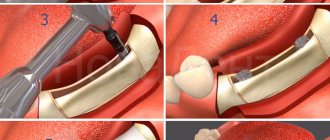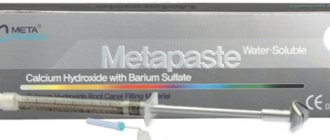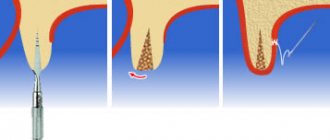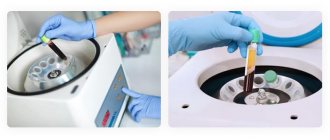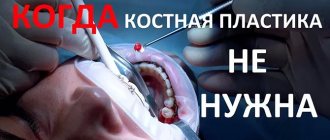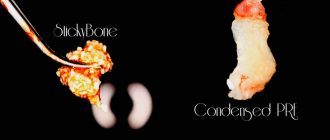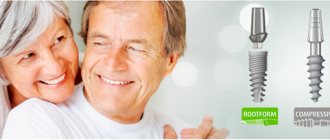686
In dental implantation and bone grafting, guided bone regeneration (GBR) is used to compensate for bone deficiency.
The main problems of NCR are migration of soft tissues into the defect area, infection of the wound by microorganisms, and low rate of osteoregeneration.
Barrier membranes best cope with these problems.
General presentation and purpose
Barrier membranes are single- or multilayer films made from artificial or natural, resorbable or non-resorbable materials.
Main functions of barrier membranes:
- stabilize the blood clot;
- exclude the formation of connective tissue in the area of the bone defect;
- prevent the penetration of microorganisms into the area of osteoregeneration;
- increase the speed and quality of osseointegration processes.
The Bio Gide membrane, produced by Geistlich Biomaterials (Switzerland), is a two-layer resorbable film made from non-cross-linked porcine collagen.
The material is recommended for use in various cases of bone tissue grafting. They cover a wound filled with crushed bone prepared from autogenous material or cattle bones.
Thanks to its unique composition and design, the material promotes accelerated and high-quality regeneration of the jaw bone and a rapid healing process of soft tissues.
Methods of implanting several teeth in a row and the designs used.
Visit here to find out what requirements apply to posterior dental implant systems.
At this address https://www.vash-dentist.ru/implantatsiya/metodiki/provokatoryi-razvitiya-gaymorita-posle.html read why sinusitis occurs after sinus lifting.
Contraindications
Due to the bone adhesion and elasticity of Bio-Gide®, it is necessary to use a grafting material to fill the space. Therefore, Bio-Gide® is not indicated for use on its own for guided bone regeneration (GBR) without the use of any filler. Bio-Guide cannot be installed if there is an active infectious process. Before installing the membrane, the surgeon must ensure that any active or recent infection has been adequately treated. The effect of the material has not been studied in pregnant women.
Characteristics
The membrane has two layers. A dense and smooth surface directed towards the soft tissues reduces water absorption and prevents cell migration into the defect fragment.
The porous three-dimensional layer facing the defect acts as a scaffold for the attachment of osteoblastic cells. Its fibrous, hydrophilic structure promotes rapid vascularization (sprouting of blood vessels), the formation of new bone cells, and accelerated wound healing.
The duration of the protective function provided by the Bio Gide membrane is sufficient for the formation of new bone.
During the manufacturing process, the material undergoes multi-stage cleaning, is sterilized using gamma radiation, and is packaged in double packaging. This completely eliminates infection of the wound by pathogenic bacteria and infections that pigs - collagen suppliers - can suffer from.
When using a Bio-Gide membrane, it is recommended to cover it with a mucous flap followed by suturing the latter. However, open wound healing, without covering with a flap, is also possible. Fixation of the film is possible using both suture material and pins.
The porcine collagen from which the membrane is made does not contain cross-linking additives, which facilitates its complete resorption. By 30-40 days, after performing its protective functions, Bio Gide is broken down by enzymes into amino acid formations, which completely, without inflammation, dissolve in the surrounding tissues.
In the supplied kits, the membrane is presented in 3 sizes: 13x25 mm, 25x25 mm, 40x50 mm.
Operating principle
Structures called Bio Guide dental membranes help in the restoration of bone and periodontal tissues. Biological agents of this type have undergone many studies over the course of 10 years. During this period, the high efficiency of the device, perfect biological compatibility and reliability were proven.
Such membranes remain in the human body for a long period of time, up to 24 weeks. This period is due to the resorption of the composition of the plate. Resorption begins only after complete restoration of the damaged tissue.
A piece of special fabric can be fixed in place of need using special pins or sewing. The material contains collagen fibers, which, when they enter the tissue, swell and trigger recovery processes. Collagen is found in every cell of the body, and with its help regeneration occurs faster. The surrounding cells are supplied with substance from the fibers of the flap.
Advantages
The dental product has multiple positive effects on bone grafting behavior:
- Prevents the migration of soft tissue into the defect area , leading to the unwanted formation of connective tissue and cartilage cells in the new bone.
- Provides rapid healing of the surgical wound , thanks to the three-dimensional structure of the membrane. The internal porous surface of the material creates optimal conditions for the growth of bone cells and blood vessels into the fibrous structure of the inner layer.
- Bio Gide has weak antigenicity , does not cause allergies or rejection, and provides excellent biocompatibility due to the preservation of the native structure of porcine collagen.
- The Bio-Gide membrane is technologically advanced. It is easy to handle and place in the wound. Due to its hydrophilicity, it adheres well to human tissues and osteomaterial, is resistant to stretching, adapts well to the shape of the defect, and maintains structural integrity even when moistened.
- The material can be used without suturing the wound (although suturing is recommended). Dehiscence of the wound edges does not interfere with healing.
- There is no need to remove Bio-Gide (repeated surgery) due to its resorbability.
- The use of Bio-Gide ensures rapid bone and tissue regeneration. According to research, the survival rate of implants using a membrane is 9.3% higher than without it.
Indications and restrictions
The Bio-Gide membrane can serve as a barrier protection for almost all types of bone grafting of the face and oral cavity. In particular:
- for facial plastic surgery to correct bone tissue defects;
- augmentation of the area around the implants , if the latter are installed in fresh extraction holes;
- in the treatment of the jawbone (filling cavities) left after implant rejection, cystectomy or root resection;
- when reforming the alveolar processes in areas of thinning.
The membrane can be used in combination with both autogenous bone and bone substitutes made from animal bones.
Contraindications
- The presence of an acute infection in the oral cavity (infected wounds).
- The patient is allergic to collagen.
- Pregnancy and lactation. There are no data on the negative consequences of using the membrane during pregnancy/lactation, but to avoid unexpected harm to the mother and child, the use of Bio-Gid is not recommended.
Use with caution in the following pathologies:
- chronic infections in the surgical area (osteomyelitis, etc.);
- decompensated metabolic pathologies (osteomalacia, diabetes mellitus, thyroid dysfunction).
- long-term treatment with corticosteroids;
- radiation therapy;
- autoimmune diseases;
- heavy smoking.
The doctor's qualifications when using membranes must be high.
How long does a tooth hurt after implantation, and what can be done?
In this article, we will tell you how to avoid nerve damage during dental implantation.
Here https://www.vash-dentist.ru/implantatsiya/metodiki/s-nemedlennoy-nagruzkoy.html we will discuss the pros and cons of implantation with immediate loading.
WARNING
The contents of the double bubble are designed for single use. Do not re-sterilize Bio-Hide. If the membrane is exposed during healing, resorption may be accelerated.
When using intraosseous implants, the membrane can only be used in the presence of stable implants. The long-term safety and effectiveness of the membrane in combination with bone filler have not yet been studied. Absolute stability of the membrane is important for targeted bone regeneration and therapeutic success; the slightest movement of the underlying tissue must be avoided.
Side effects
Bio-Gide film is biocompatible with human body tissue. Allergies are possible only in rare cases with individual intolerance.
Possible temporary reactions that occur during any surgical intervention:
- swelling in the area of the surgical wound;
- local inflammation;
- pain.
Sometimes, rarely, tissue flap rejection, bleeding, and infection are possible. The necessary actions in specific cases are determined by the doctor depending on the clinical situation.
If necessary, the surgical wound is exposed and subjected to curettage and other routine surgical procedures.
POSTOPERATIVE PERIOD
- Careful monitoring of the patient is necessary.
- If the membrane is exposed, it usually closes on its own within a few weeks. Membrane removal is usually NOT indicated. However, to minimize bacterial contamination, rinsing with bactericidal solutions is recommended.
- If it is necessary to remove the membrane prematurely, it is necessary to numb the adjacent tissues using a local anesthetic. The incision should be made in the tissue area adjacent to the membrane. After carefully folding back the flap, the remaining membrane is removed and the area is curetted to remove inflamed or infected tissue.
- To ensure bone regeneration under the membrane, re-intervention in this area should not be carried out earlier than 4-6 months after installation of the membrane.
Application Guide
The oral cavity must be clean before surgery. The patient receives recommendations on dental and oral care. If necessary, professional cleaning is carried out.
The use of the membrane must be carried out in compliance with the principles of sterility applicable to any surgical intervention.
The material is used in the following sequence:
- The defect is filled with autogenous bone or a bone substitute (Bio-Oss or others).
- The membrane is removed from the packaging and cut with scissors to the desired size. For convenience, templates made of aluminum foil or other suitable sterile material may be used.
The Bio-Gide kit contains templates for the most commonly used periodontal forms. The dimensions of the defect must be covered by the membrane by at least 2 mm. This is necessary to prevent connective tissue growth into the newly formed bone. - The product is placed in the wound over the defect. The dense surface marked with the “UP” sign should be located outside the wound area, and the rough surface should be located towards the defect.
Moderate pressure is used to secure the membrane. The pressure time is individual, depending on the speed of impregnation of the membrane. For good adhesion to the wound, the material must be well saturated with blood and exudate. Surgical threads or pins can be used to fix it. - If there is a flap, it is carefully, without tension, sutured with a single thread.
- It is desirable that the wound closes completely. This will prevent the exposed portion from being absorbed too quickly.
However, if the wound cannot be completely closed, this is not an obstacle to the healing process. Clinical practice shows that in most cases, with an open membrane, the healing process proceeds normally. - Postoperative care should ensure the absence of complications. This is achieved by strictly following the recommendations given by the doctor. The most important of them is strict adherence to PR hygiene and the prevention of bacterial infections.
Precautionary measures
To prevent the formation of connective tissue epithelium in the wound, the membrane must adhere tightly to the tooth or implant. If necessary, suture material should be used.
Other recommendations:
- Use opened material only once. Unused membrane must be disposed of and its reuse is prohibited.
- Do not use membrane that has expired.
- Store the material at a temperature of 15-25 °C in a dry place.
The video provides an overview of the material's properties.
Reviews
Barrier membranes are always used in combination with autogenous or bone replacement drugs. Therefore, the outcome of the operation depends not only on its quality, but also on the characteristics of the bone materials.
If you have undergone augmentation using a Geistlich membrane or another manufacturer, please share your experience with us by leaving a comment at the bottom of the page.
If you find an error, please select a piece of text and press Ctrl+Enter.
Tags implantation bone materials
Did you like the article? stay tuned
Previous article
Detailed and accessible information about how and when braces are removed
Next article
Review of biocompatible and aesthetic zirconium implants
